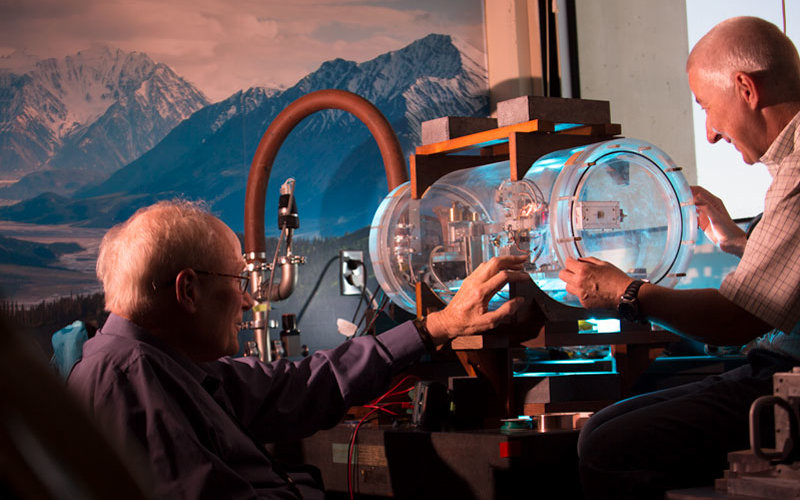
Cal State Fullerton physics researchers James F. Woodward and Heidi Fearn share the same out-of-this world mission: to get around space-time faster and farther — beyond the solar system and into interstellar space to find out if life exists beyond Earth.
While it may sound like a sci-fi fantasy, their vision and research efforts landed the space scientists a two-year $500,000 NASA Innovative Advanced Concepts Phase II grant to advance their study on space propulsion for future human exploration missions.
“If our concept is successful, it would revolutionize space exploration,” Fearn said. “It would be a serious game-changer. NASA can literally go to the stars.”
NASA selected 25 early-stage technology proposals, including Woodward’s “Mach Effect for In-Space Propulsion: Interstellar Mission.” The grant was awarded to the Mojave-based nonprofit Space Studies Institute, with Woodward and Fearn directing the research effort at CSUF.
Woodward is an experimental physicist and professor emeritus of history, with expertise in the history of science and Einstein’s general theory of relativity. He and Fearn, professor of physics, were awarded a $125,000 NASA Innovative Advanced Concepts Phase I grant in 2017 to develop a feasibility study for their “MEGA drive propulsion” research to develop an interstellar probe.
NASA selected projects through a peer-review process that evaluated innovation and technical viability. Phase II studies are given to the most successful Phase I fellows whose “ideas have the best possibility of changing the possible,” according to NASA.
For this next phase of their research, Woodward and Fearn will collaborate with experts from industry and academia, including those at Johns Hopkins University, in hopes of successfully developing a breakthrough technology. Machinist Jonathan Woodland in the Physics Department and a student researcher also will be involved in the project.
For about four decades, Woodward has been working to develop a method of propulsion for a starship that does not require propellant. He has a lab in the Physics Department, and he and Fearn also collaborate with the Space Studies Institute, which in 2013 launched its exotic propulsion initiative, to advance their research.
“Propulsion without propellant is what is needed to get us to the stars,” said Woodward, author of “Making Starship and Stargates: The Science of Interstellar Transport and Absurdly Benign Wormholes.”
“We have the revolutionary capability to produce thrust without the ejection of propellant. No consumable fuel is needed, and nothing is ejected out of a tailpipe like a chemical rocket,” Woodward said of his experimental research. “It’s a promising approach.”
The research focuses on the “Mach Effect Gravitational Assist” drive, or MEGA impulse drive, and referred to as the “Woodward effect” by fellow scientists and space enthusiasts. It works on the principle that all the mass in the universe is connected, and mass on Earth is due to mass everywhere else, explained Fearn, who has collaborated with Woodward since 2012.
Woodward’s Mach effect research is predicted by standard physics and the theory of relativity, which he discusses in his book and also resulted in more than a dozen peer-reviewed papers. The researchers also have presented their pioneering work at numerous conferences, including at the April “Breakthrough Discuss” scientific conference at Stanford University.
To produce thrust, the MEGA drive device uses electricity that could come from a nuclear battery, which has a 25- to 30-year lifespan. The Mach effect research applied to an interstellar probe, for example, would take about 20 years to reach a destination of up to 5 light-years in distance, compared to today’s rockets that would take 17,000 years get to the potentially Earth-like planet Proxima b, Fearn said.
“If we ever want to get out of our solar system and colonize a new planet, this propellantless propulsion MEGA device is a first step,” added Fearn, who once dreamed of being an astronaut and is a superfan of “Star Trek.”
“Our goal is to send an interstellar probe to Proxima b. There could be life on that planet!”